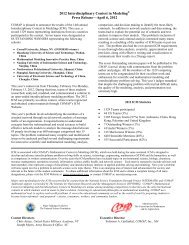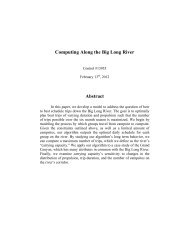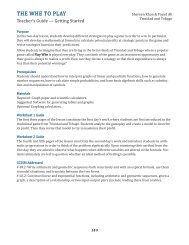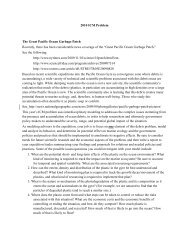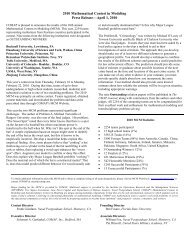Centroids, Clusters and Crime: Anchoring the Geographic Profiles of ...
Centroids, Clusters and Crime: Anchoring the Geographic Profiles of ...
Centroids, Clusters and Crime: Anchoring the Geographic Profiles of ...
You also want an ePaper? Increase the reach of your titles
YUMPU automatically turns print PDFs into web optimized ePapers that Google loves.
Team # 7507 Page 43<br />
In addition, <strong>the</strong> st<strong>and</strong>ard warnings that would apply to any geographic pr<strong>of</strong>iling scheme<br />
apply: The output should not be treated as a single prediction, but ra<strong>the</strong>r as a tool to help<br />
prioritize areas <strong>of</strong> focus. It is designed to do well on average, but may fail in outlier cases.<br />
And to implement it reliably, it must be paired with a human assessment. Please note also<br />
that models for predicting <strong>the</strong> <strong>of</strong>fenders “home base” are much more well-researched, <strong>and</strong> in<br />
general will be more accurate than any algorithm claiming to predict <strong>the</strong> next strike point. A<br />
police department should choose which model type to use on a case-by-case basis.<br />
Internal Workings <strong>of</strong> <strong>the</strong> Model<br />
Inputs<br />
Our model requires <strong>the</strong> coordinate locations <strong>of</strong> a serial criminal’s previous <strong>of</strong>fenses, as well as<br />
<strong>the</strong> order in which <strong>the</strong>se crimes were committed.<br />
Assumpitons<br />
1. The Criminal will tend to strike at locations around one or more “anchor points.” (<strong>of</strong>ten,<br />
<strong>the</strong> criminal’s house).<br />
2. Around this anchor point, <strong>the</strong>re may be a “buffer zone” within which he will not strike.<br />
3. If <strong>the</strong> criminal has multiple anchor points, <strong>the</strong> regions around those from which he has<br />
struck most <strong>of</strong>ten or most recently are more likely.<br />
Method<br />
The algorithm implements two different models, <strong>and</strong> <strong>the</strong>n decides which is better.<br />
• In <strong>the</strong> first method, we assume <strong>the</strong> criminal has a single anchor point, <strong>and</strong> build likelihood<br />
regions around <strong>the</strong> anchor point based on <strong>the</strong> distribution <strong>of</strong> his past crimes.<br />
• In <strong>the</strong> second, we assume multiple anchor points, calculate <strong>the</strong> best number <strong>of</strong> anchor<br />
points to use, <strong>and</strong> determine likelihood around each point individually. Then area around<br />
each is weighted by <strong>the</strong> criminal’s apparent preferences, if any.<br />
Finally, <strong>the</strong> algorithm tests both models to see how well <strong>the</strong>y would have predicted <strong>the</strong><br />
previous crimes, <strong>and</strong> uses <strong>the</strong> model with <strong>the</strong> better track record.<br />
Summary <strong>and</strong> Recommendations<br />
While our model needs more real-world testing, its strong <strong>the</strong>oretical basis, self-evaluation<br />
scheme <strong>and</strong> awareness <strong>of</strong> practical considerations make it a good option for a police department<br />
looking to forecast a criminal’s next strike. Combining its results with <strong>the</strong> intuition <strong>of</strong> a human<br />
being will maximize its utility.







